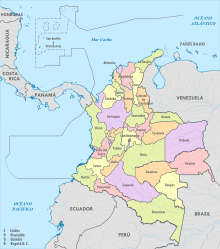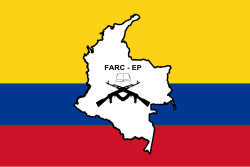Narcoterrorism, in its original context, is understood to refer to the attempts of narcotics traffickers to influence the policies of a government or a society through violence and intimidation, and to hinder the enforcement of anti-drug laws by the systematic threat or use of such violence. As with most definitions of terrorism, it typically only refers to non-state actors.
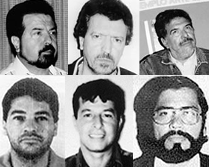
The Cali Cartel was a drug cartel based in southern Colombia, around the city of Cali and the Valle del Cauca. Its founders were the brothers Gilberto Rodríguez Orejuela, Miguel Rodríguez Orejuela and José Santacruz Londoño. They broke away from Pablo Escobar and his Medellín associates in 1988, when Hélmer "Pacho" Herrera joined what became a four-man executive board that ran the cartel.
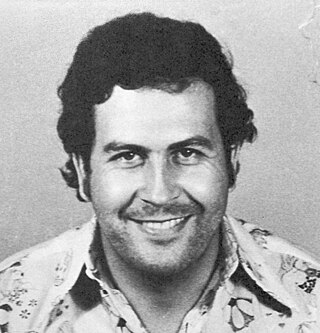
The Medellín Cartel was a powerful and highly organized Colombian drug cartel and terrorist organization originating in the city of Medellín, Colombia, that was founded and led by Pablo Escobar. It is often considered to be the first major "drug cartel" and was referred to as such; due to the organization's upper echelons and overall power-structure being built on a partnership between multiple Colombian traffickers operating alongside Escobar. Included were Jorge Luis Ochoa Vásquez, Fabio Ochoa Vásquez, Juan David Ochoa Vásquez, José Gonzalo Rodríguez Gacha and Carlos Lehder. Escobar's main partner in the organization however was his cousin Gustavo Gaviria who handled much of the cartel's shipping arrangements and the more general and detailed logistical aspects of the cocaine trafficking routes and international smuggling networks which were supplying at least 80% of the world's cocaine during its peak. Gustavo, also known as León seems to have also had a strong hand in the cartel's unprecedented acts of narcoterrorism, right alongside his cousin Pablo and was considered to be second in command of the cartel and therefore one of Colombia's most wanted men, with both him and Escobar having arrest warrants pending from other nations where their criminal activity had spread to, such as in Spain and the U.S. Meanwhile, Pablo Escobar's brother Roberto Escobar acted as the organization's accountant. The cartel operated from 1976 to 1993 in Colombia (Antioquia), Bolivia, Panama, Central America, Peru, the Bahamas, the United States, as well as in Canada.
Carlos Castaño Gil was a Colombian paramilitary leader who was a founder of the Peasant Self-Defenders of Córdoba and Urabá (ACCU), a far-right paramilitary organisation in Colombia and a former member of the Medellin Cartel. Castaño and his brothers Fidel and Vicente founded the ACCU after their father was kidnapped and killed by the Revolutionary Armed Forces of Colombia (FARC), in association with other enemies or victims of the guerrillas. The ACCU later became one of the founding members of the United Self-Defense Forces of Colombia (AUC).
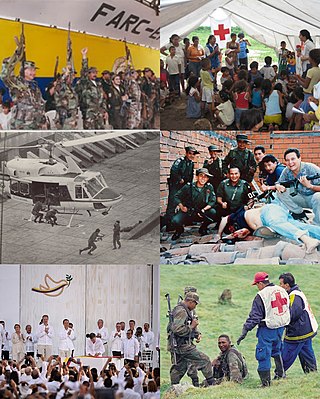
The Colombian conflict began on May 27, 1964, and is a low-intensity asymmetric war between the government of Colombia, far-right paramilitary groups and crime syndicates, and far-left guerrilla groups, fighting each other to increase their influence in Colombian territory. Some of the most important international contributors to the Colombian conflict include multinational corporations, the United States, Cuba, and the drug trafficking industry.

This article covers national and international security issues in Colombia.
The FARC-Government peace process (1999–2002), from January 7, 1999, to February 20, 2002, was a failed peace process between the Government of President Andrés Pastrana Arango and the Revolutionary Armed Forces of Colombia (FARC) guerrilla group in an effort to bring to an end the ongoing Colombian armed conflict.

José Gonzalo Rodríguez Gacha, also known by the nicknames Don Sombrero and El Mexicano, was a Colombian drug lord who was one of the leaders of the Medellín Cartel along with the Ochoa brothers and Pablo Escobar. At the height of his criminal career, Rodríguez was acknowledged as one of the world's most successful drug dealers. In 1988, Forbes magazine included him in their annual list of the world's billionaires.

Francisco Hélmer Herrera Buitrago also known as "Pacho" and "H7", was a Colombian drug trafficker, fourth in command in the Cali Cartel, and believed to be the son of Benjamín Herrera Zuleta.

The illegal drug trade in Colombia has, since the 1970s, centered successively on four major drug trafficking cartels: Medellín, Cali, Norte del Valle, and North Coast, as well as several bandas criminales, or BACRIMs. The trade eventually created a new social class and influenced several aspects of Colombian culture, economics, and politics.

The illegal drug trade in Latin America concerns primarily the production and sale of cocaine and cannabis, including the export of these banned substances to the United States and Europe. The coca cultivation is concentrated in the Andes of South America, particularly in Colombia, Peru and Bolivia; this is the world's only source region for coca.

Los Rastrojos is a Colombian drug cartel and paramilitary group engaged in the Colombian armed conflict. The group was formed by Norte del Valle cartel capo Wilber Varela, alias "Jabon" and one of his right-hand men, "Diego Rastrojo", around 2004 when Varela fell out with fellow-capo Diego Leon Montoya, alias "Don Diego". The group became independent after the murder of its main founder in Venezuela in 2008 and at its height was one of the most important drug trafficking organizations in Colombia.
Colombia has a high crime rate due to being a center for the cultivation and trafficking of cocaine. The Colombian conflict began in the mid-1960s and is a low-intensity conflict between Colombian governments, paramilitary groups, crime syndicates, and left-wing guerrillas such as the Revolutionary Armed Forces of Colombia (FARC), and the National Liberation Army (ELN), fighting each other to increase their influence in Colombian territory. Two of the most important international actors that have contributed to the Colombian conflict are multinational companies and the United States.

The Clan del Golfo, also known as Gaitanist Self-Defense Forces of Colombia and formerly called Los Urabeños and Clan Úsuga, is a prominent Colombian neo-paramilitary group and currently the country's largest drug cartel.
La Oficina de Envigado is a drug cartel and criminal organization originally founded as an enforcement wing and debt collection service of Pablo Escobar's Medellín Cartel. Despite being noted for its historical affiliation with drug trafficking and other organized crime activities, Oficina de Envigado's criminal activities were no longer centered on direct involvement in such activity by 2019 and are now mainly focused on providing services to lower level drug traffickers and mafia groups. It operates throughout Colombia, but mainly in the cities of Medellín and Envigado. It also controlled extortion, gambling, and money laundering businesses within the Valle de Aburrá that surrounds Medellín. It positioned itself as the chief mediator and debt collector in drug trafficking disputes and maintained major connections with Colombian paramilitaries and guerillas.

Drug barons of Colombia refer to some of the most notable drug lords which operate in illegal drug trafficking in Colombia. Several of them, notably Pablo Escobar, were long considered among the world's most dangerous and most wanted men by U.S. intelligence. "Ruthless and immensely powerful", several political leaders, such as President Virgilio Barco Vargas, became convinced that the drug lords were becoming so powerful that they could oust the formal government and run the country.
Terrorism in Colombia has occurred repeatedly during the last several decades, largely due to the ongoing armed conflict the country has been involved in since 1964. Perpetrators of terrorist acts in the country range from leftist guerilla forces including FARC, ELN and M-19, to drug cartels such as the Medellín Cartel, to right-wing paramilitary forces including the AUC.

FARC dissidents, also known as Carlos Patiño Front, are a group, formerly part of the Revolutionary Armed Forces of Colombia (FARC), who have refused to lay down their arms after the Colombian peace process came into effect in 2016, or resumed their insurgency afterwards. In 2018, the dissidents numbered some 2,000, to 2,500, armed combatants with an unknown number of civilian militia supporting them. The FARC dissidents have become "an increasing headache" for the Colombian armed forces, as they have to fight them, the Popular Liberation Army (EPL), the National Liberation Army (ELN), and the Clan del Golfo at the same time.
Maritime cocaine smuggling refers to the practice which involves the smuggling of cocaine between borders via maritime means. According to the United Nations Office on Drugs and Crime (UNODC), there are an estimated 18 million users of cocaine globally. Approximately 70-80% of cocaine is at some point smuggled across the ocean, originating from South America. Cocaine remains the "highest value criminal commodity for transnational organised crime", motivating the criminal organisations responsible for maritime smuggling practices. Maritime cocaine smuggling is therefore an ongoing international issue, as criminal organisations are finding new and innovative ways of smuggling cocaine and go undetected by authorities.

The cocaine boom was a stark increase in the illegal production and trade of the drug cocaine that first began in the mid to late 1970s before then peaking during the 1980s. The boom was the result of organized smugglers who imported cocaine from Latin America to the United States, and a rising demand in cocaine due to cultural trends in the United States. Smuggling rings of Cuban exiles organized trade networks from Latin America to Miami that streamlined the import of cocaine to the United States. Americans also began favoring less of the drugs popular in the 60s counterculture such as marijuana and LSD, and instead began to prefer cocaine due to a mystique of prestige that was developing around it. This increase in cocaine trade fueled the rise of the crack epidemic and government sponsored anti-drug campaigns.
